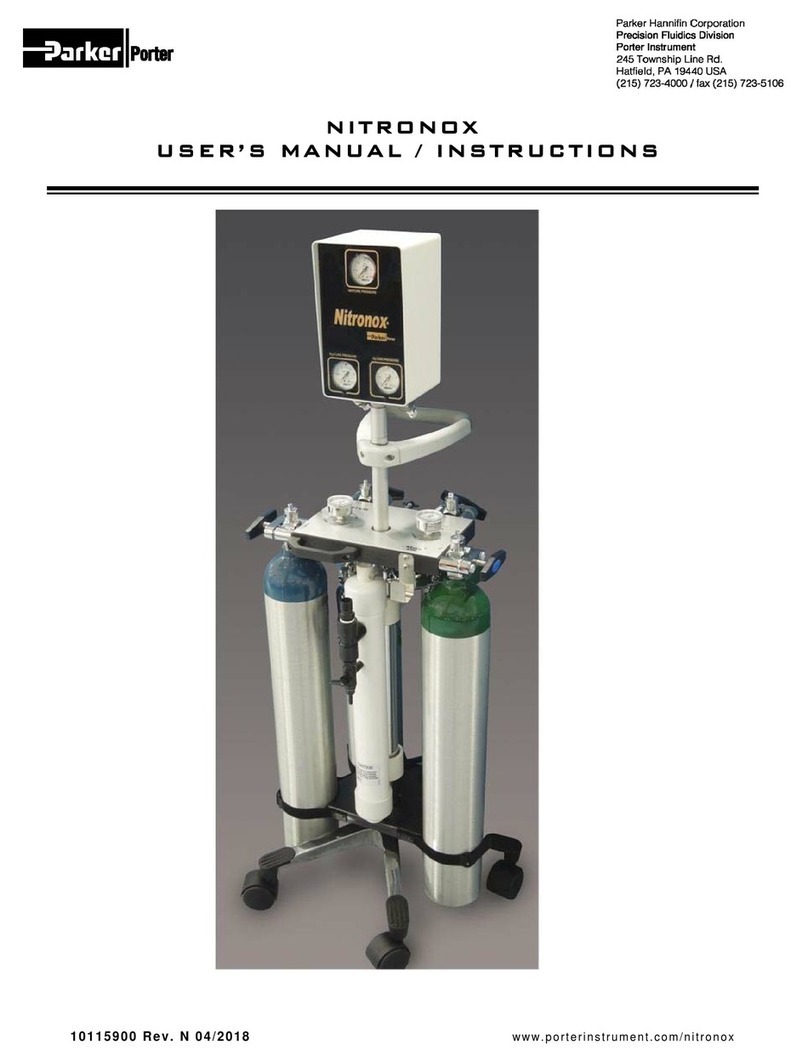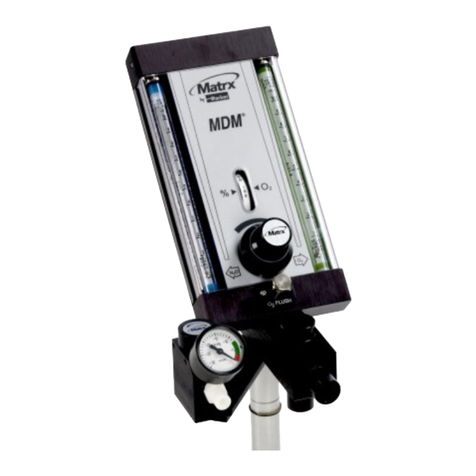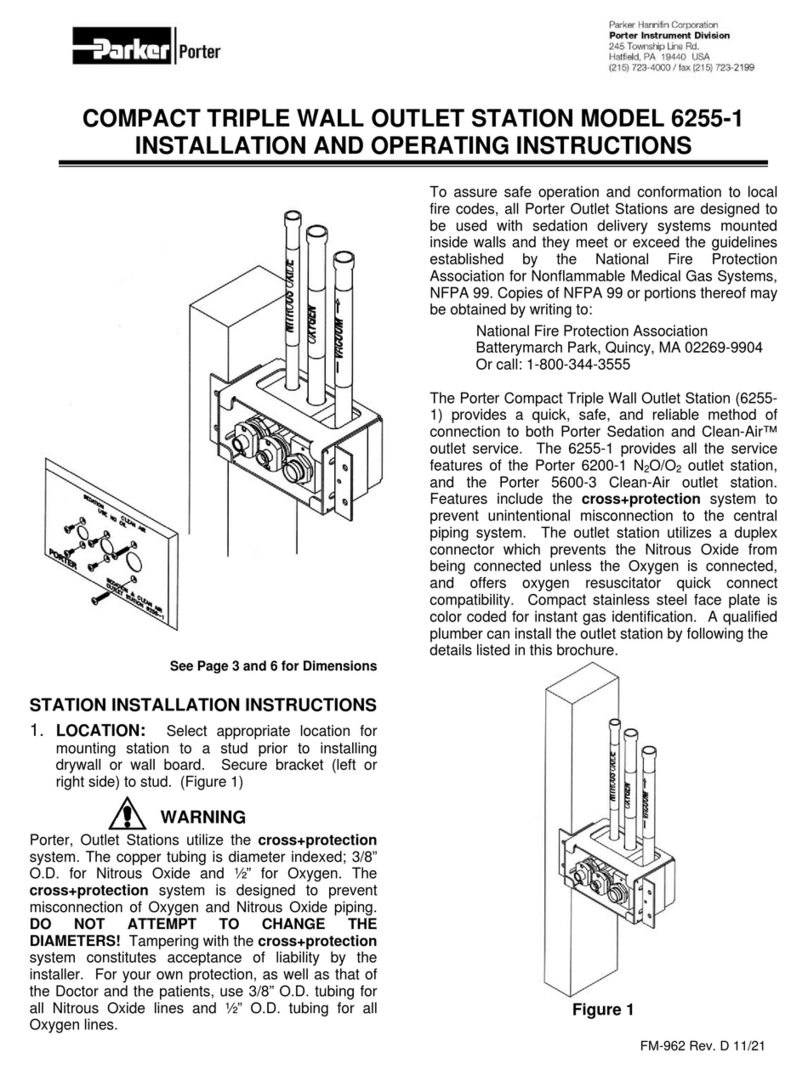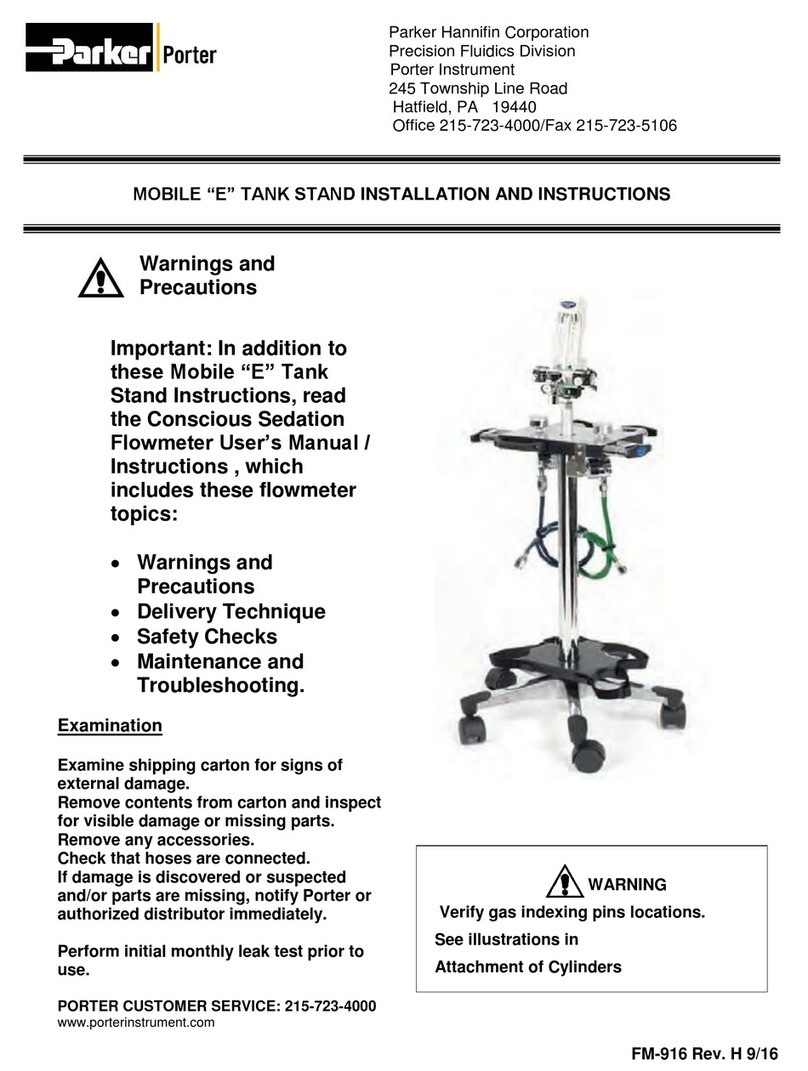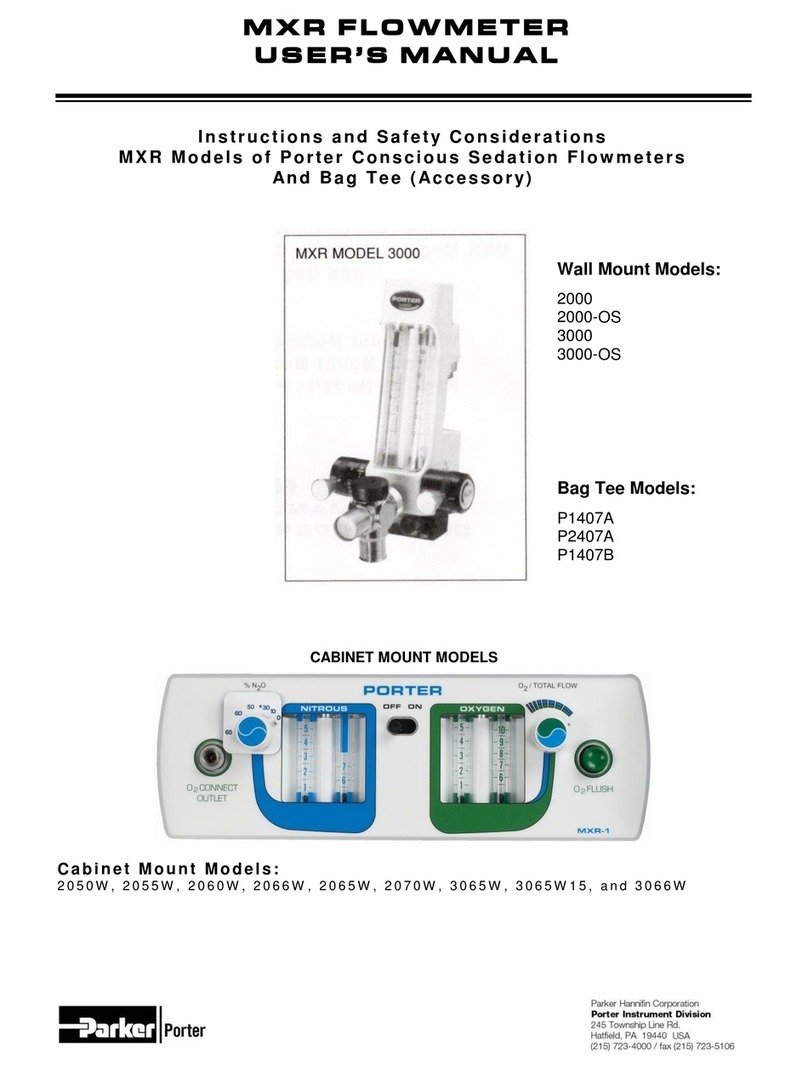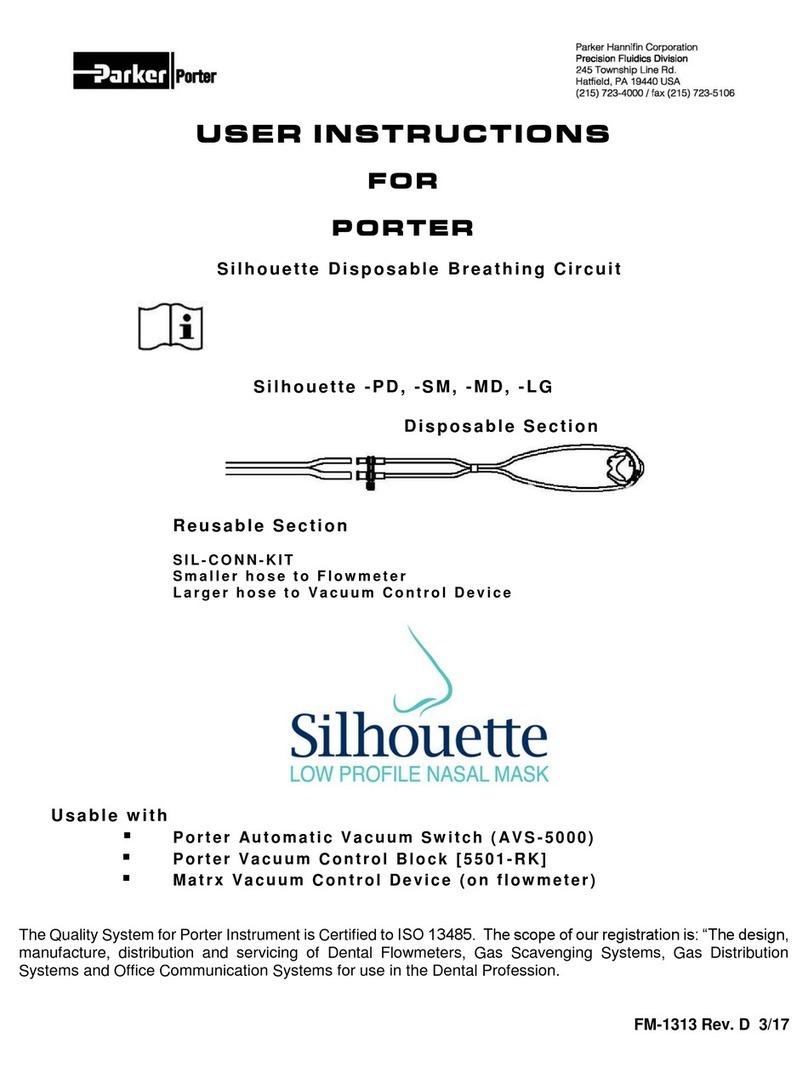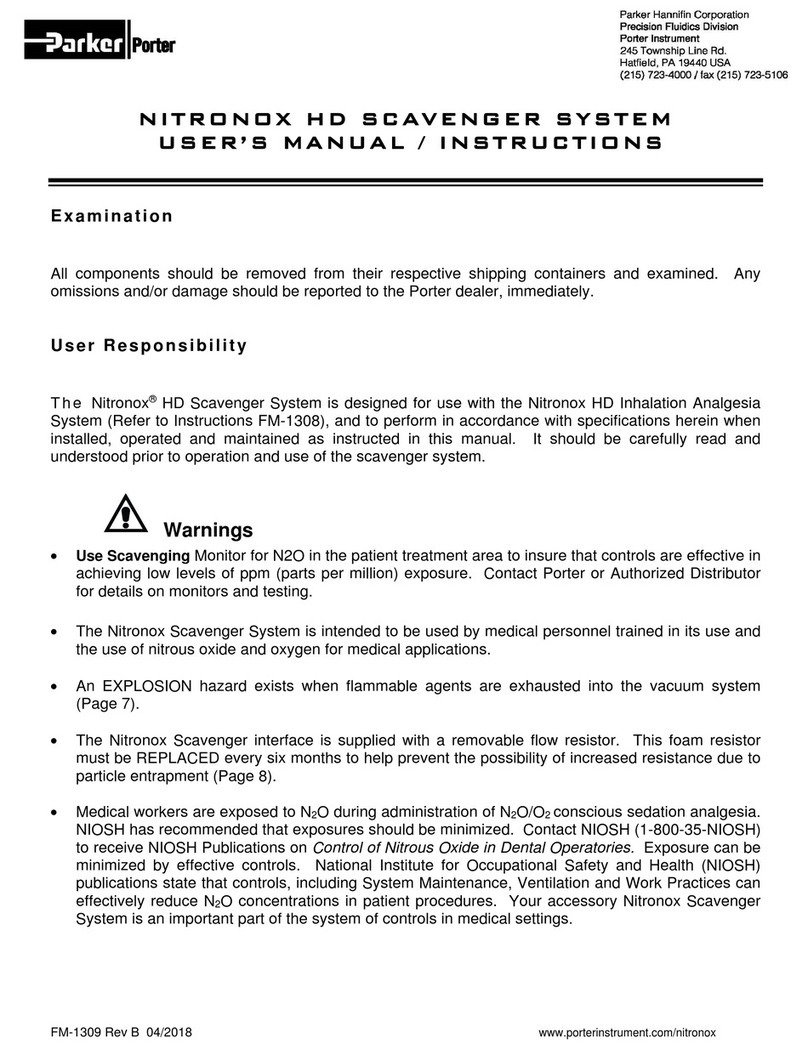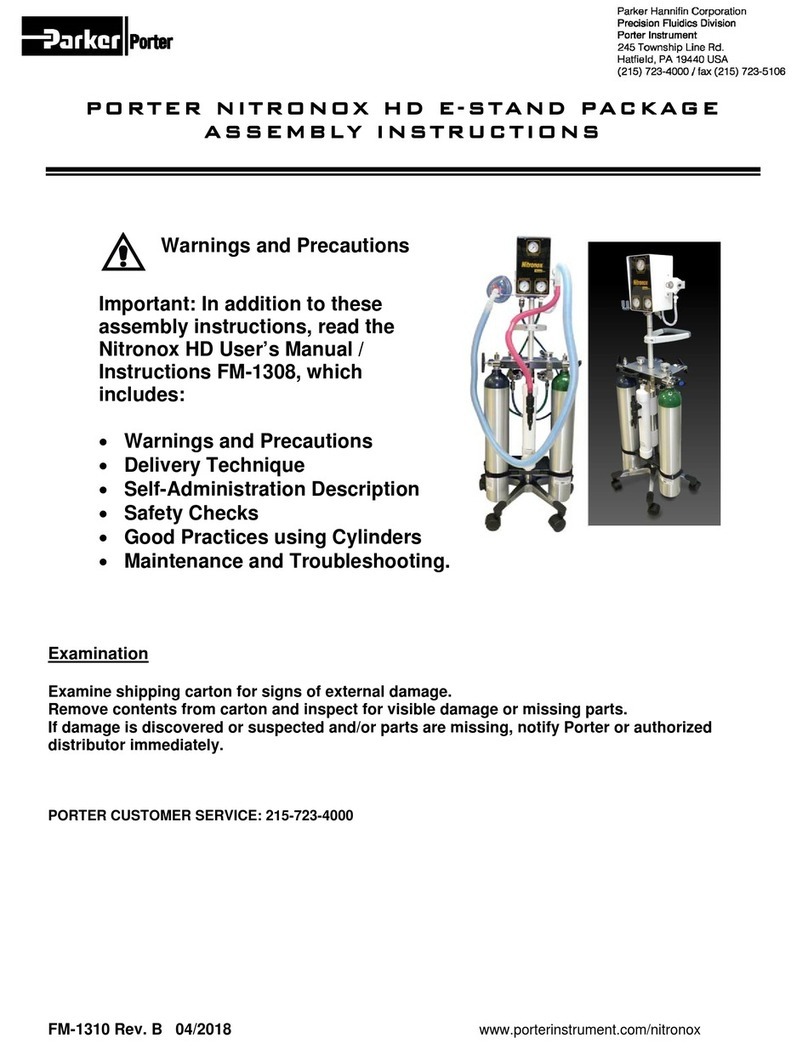
2. PIPING REQUIREMENTS
2.1. Sedation Outlet Connections (N2O/O2)
This portion of the 6256-3 outlet station has
the option of unscrewing the gas block,
(N2O/O2)(Fig. 2) from the support plate
(three screws), inverting the block (Fig. 3) so
the pipes may extend downward (Fig. 4).
2.2. IMPORTANT: When remounting the
blocks to the support plate use the lower set
of holes on the plate (Fig. 4) to insure the
faceplate will line up. (Note: This is only
when pipes are pointing down.)
2.3. Pipes can then be joined to their appropriate
3/8” OD tube for Nitrous Oxide, and ½” OD
tube for Oxygen. (See section below.)
2.4. Central Suction Powered Systems:
Determine the direction in which the piping
is needed.
2.5. If the vacuum tube (1/2” OD) is required in
the upward position, be aware that moisture
could drain back into the tubing. It is
recommended that a trap be used.
2.6. If the vacuum tube (1/2” OD) is required in
the downward position, unscrew the vacuum
block from the support pole (two screws),
invert the block (Fig. 5) and screw the
vacuum block back onto the support plate.
2.7. IMPORTANT: When remounting the block
to the support plate use the upper set of
holes on the plate. (Note: This is only when
pipe is pointing down.)
3. DRYWALL OR WALL BOARD CUT-
OUT AND STATION FIXTURING
DETAILS
3.1. Closing up walls requires a 2 ¾” H. x 6 3/8”
L. cut-out opening. See template diagram
for actual cut-out outline.
3.2. Bracket “B” butts up to underside of drywall.
Pan Head tapping screws with washers,
pinch drywall in place for fastening right end
of unit securely.
4. INSTALL THE GAS SUPPLY LINES:
Note: The station is designed and intended to be
used with gas supply lines installed using NFPA
99 guidelines, including a 150 PSI piping integrity
test. Medical grade dry Nitrogen should be used
as a “forming gas” while soldering. To prevent
oxidation inside supply lines:
(a) Use type K or L, pre-cleaned, degreased,
capped copper tubing ONLY.
(b) Use 3/8” O.D. for Nitrous Oxide; use ½” O.D.
for Oxygen. DO NOT CHANGE TUBING
DIAMETERS!!
(c) All copper to copper joints are to be made
using a brazing allows conforming to AWS
Classification BcuP-5 (see AWS Std. A5.8).
Flux shall not be used.
(d) After connecting all gas lines, check the
system for leaks with dry Nitrogen per NFPA
99.
5. Check for Crossed Lines. (Refer to NFPA
Gas and Vacuum Systems Code for Type II
Systems) (See cross+protection Warning in
this brochure.)
3
AFTER DRY WALL IS INSTALLED
6. Remove cover cap. Check to make sure leading
edge of box is flush with dry wall. If U shaped
bracket is incorrectly aligned, loosen bracket
mounting nuts with a 3/8” open end wrench,
adjust to fit, re-tighten nuts.
7. Alignment & Adjustment for Front Plate
Installation – The Oxygen and Nitrous Oxide
Valve Bodies are factory adjusted to allow for the
back of the Front Plate to press against the metal
surfaces of all three valve bodies. If adjustment
is needed, follow these steps:
7.1. Rotate the Oxygen and Nitrous Oxide valve
bodies so they both uniformly contact the
back of the Front Plate. Oxygen has right
hand threads and Nitrous Oxide has left
hand threads.
7.2. Adjust the right hand thread vacuum valve
body to align with the metal surfaces of the
other valve bodies.
4
8. Install Front Plate with the six 4-40 flat head
screws.
9. Apply diameter indexed N2O/O2gas label in
place over diameter indexed check valve
connector bushings. Pull off center strip backing,
and press label in place. Remove top and
bottom backing strips, and finish securing label.
10. Connect an 8060 series duplex connector and
hoses into the completely assembled Triple
Outlet Station. Attach the other end of the hoses
to a flowmeter and turn the flow control knobs to
the off position and the on/off switch to the off
position.
11. Leak test the entire system for working
pressure leaks.Pressurize the sedation gas
supply lines with 50 PSI. Observe any pressure
decay after 12 hours. This 50 PSI test with the
flowmeter tubing connections in place tests the
seal of the duplex connector extended into the o-
rings of the outlet station primary check valves.
(5 PSI drop allowed.)
12. Attach the appropriate vacuum lines from the
HVE attachment to the station vacuum line.
CONNECTIONS TO FLOWMETER –
OPERATING INSTRUCTIONS
Flowmeter Gas Supply Tubing and Vacuum Tubing is
connected to the Triple Outlet Station via two quick
connect couplers. The Porter 8060 series duplex
connector simultaneously connects the Oxygen and
Nitrous oxide tubing, and prevents the Nitrous Oxide
from being connected unless the Oxygen is
connected. The Porter 5602 vacuum quick connect
with hose barb separately inserts into the vacuum
check valve of the station.
QUICK CONNECTING
You may quick connect to the station when the
system pressure is at its normal 50 PSI; the primary
check valves seal this pressure. Both couplers have
locating latches. Simply insert the couplers into the
appropriate check valve and confirm the latch is in
place behind the catch feature of the valve. A gentle
tug on the coupler will confirm a stable latch position.
Internally, within the primary check valve, an o-ring
seals against a poppet. The same o-ring seals
against the quick connect extensions upon insertion.
Slide the latch out of position to remove the
connector and the internal poppet will automatically
move back into its sealing position.
RESUSCITATOR
Remove the duplex connector so a resuscitator quick
connects may be inserted into the oxygen station
position.
MAINTENANCE AND SERVICE
Use Scavenging
Monitor for N2O in the operator to insure that
controls are effective in achieving low levels of ppm
(parts per million) exposure. Contact your Porter
dealer for details on monitors and testing.
Inspect and maintain the analgesia delivery
system to prevent N2O leaks in all hoses,
connections and fittings. Repair all leaks
immediately.
Fig. 2
Fig. 3
Fig. 4
DRYWALL CUT-OUT
(ACTUAL SIZE) 23⁄4"
63⁄8"
BRACKET “A”
TEMPLATE DIAGRAM
(2) 3⁄16"dia. holes
STUD
See note #7
Fig. 5
BRACKET
“A”
BRACKET
“B”
BRACKET
“B”
Cut-Out
Right Edge
63⁄8"
23⁄4"
For Stock
No. 6256-3 1"
63⁄4"
71⁄2"
43⁄4"
21⁄8"
Fits into
Standard
2x3/2 x 4
Construction
Wall
PULL
3 42
